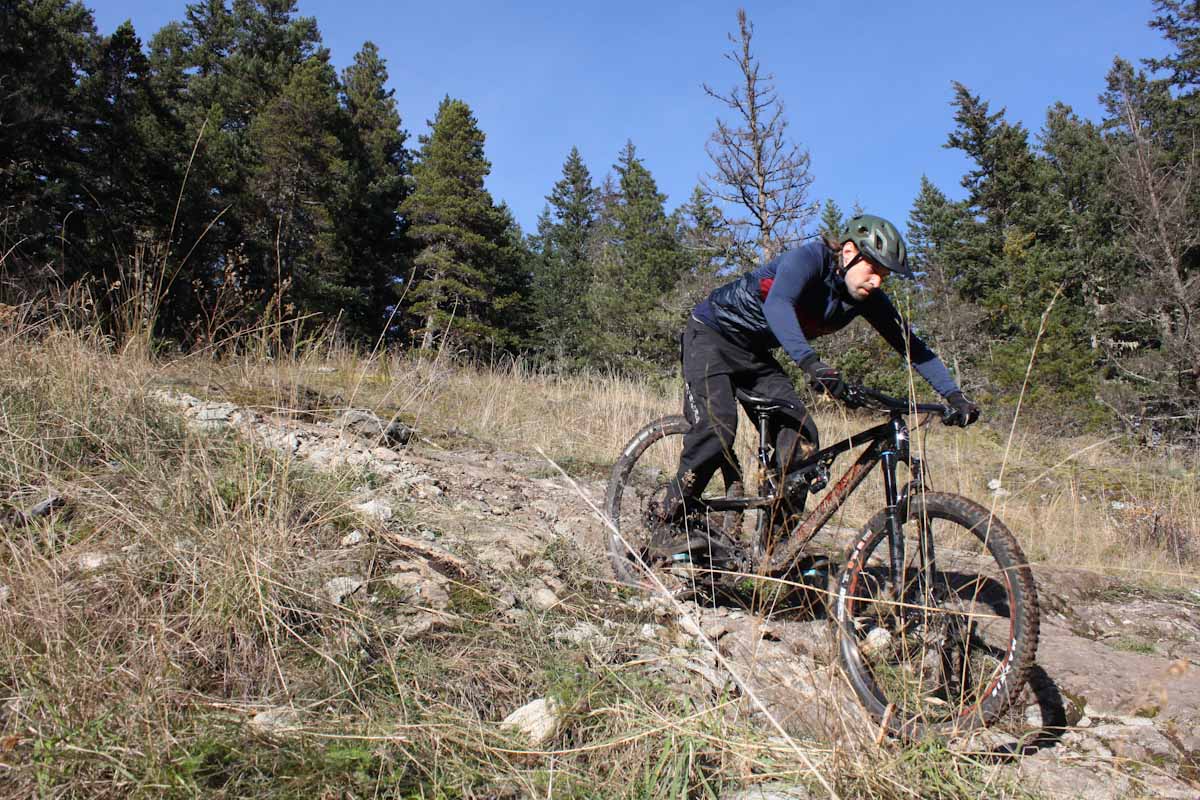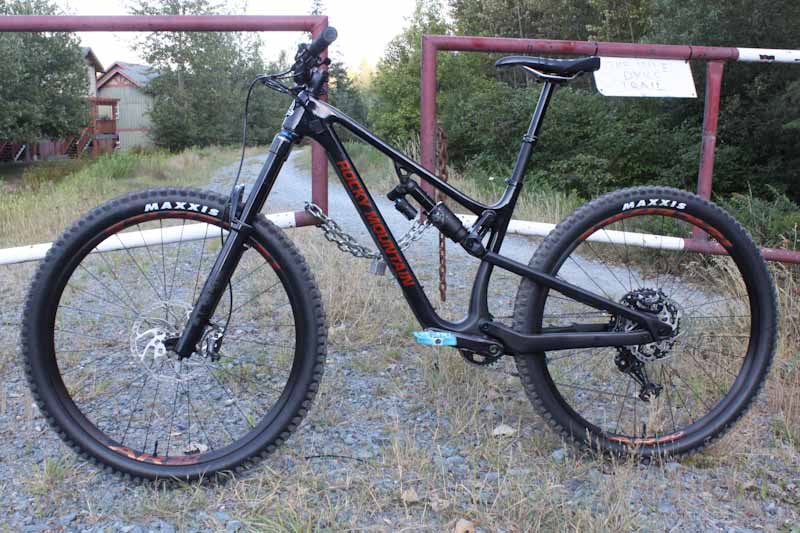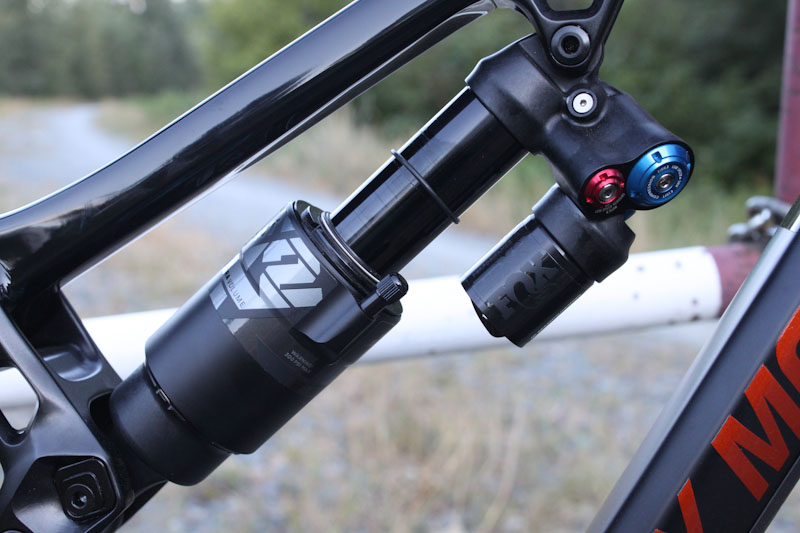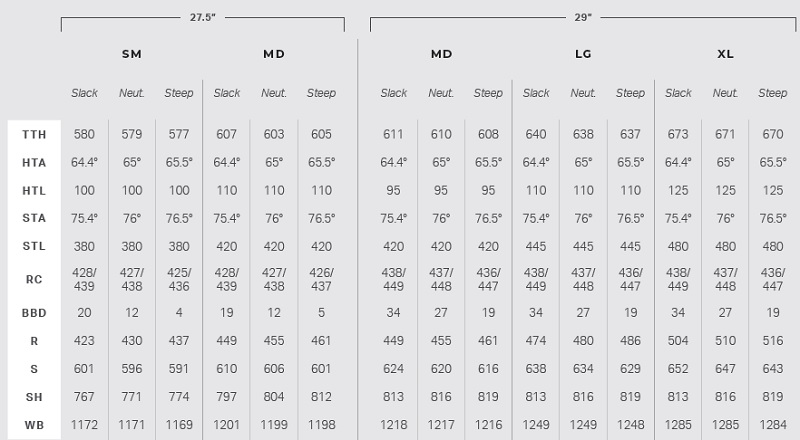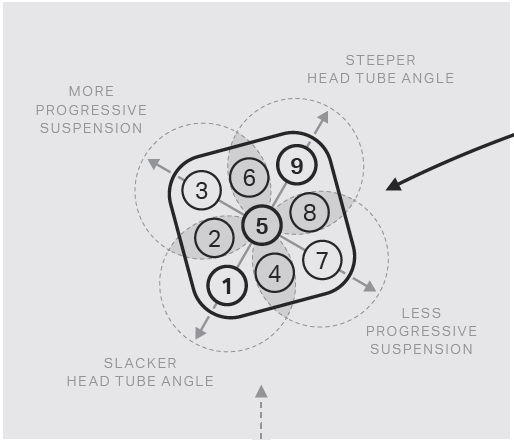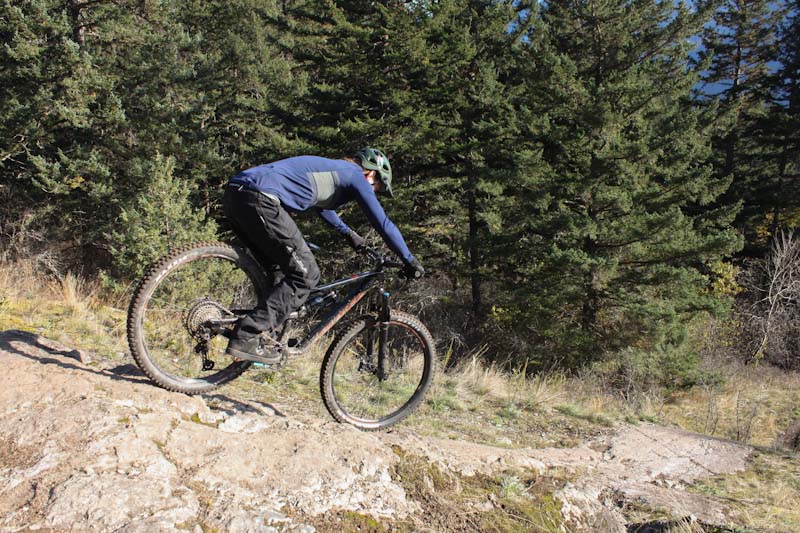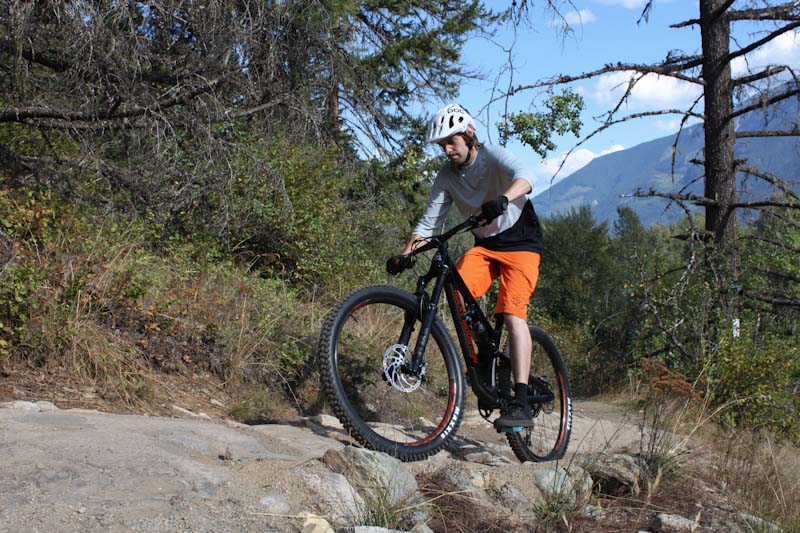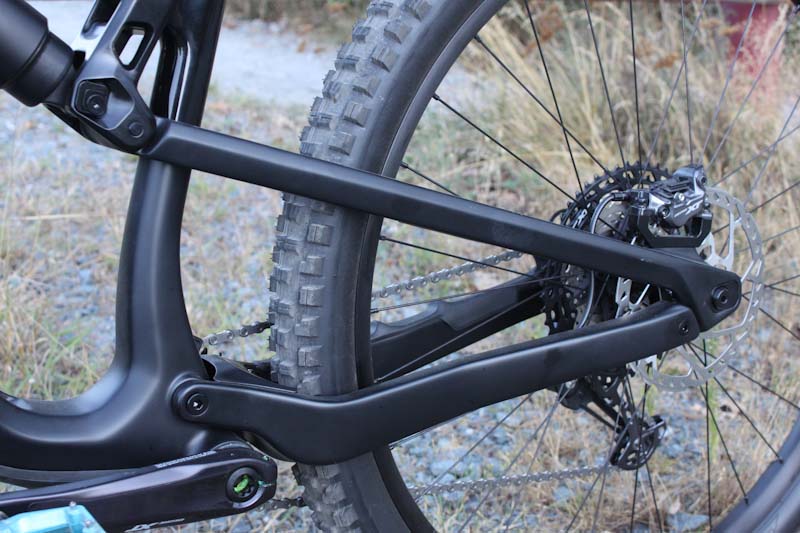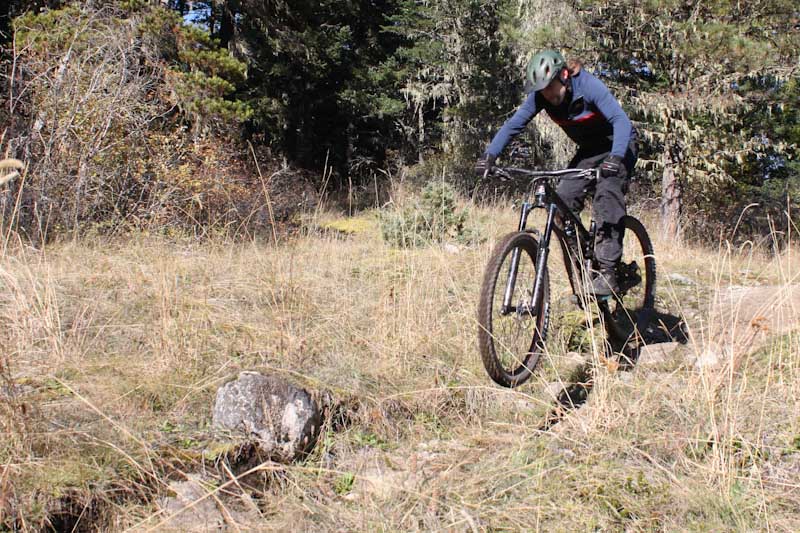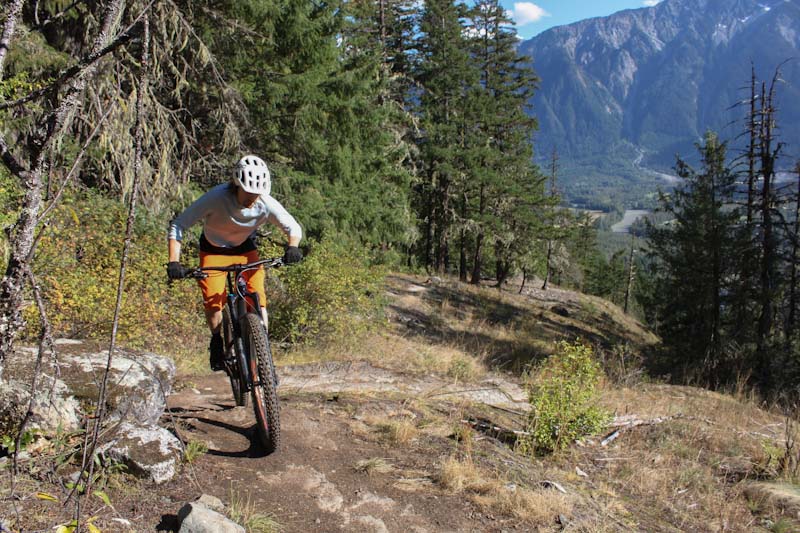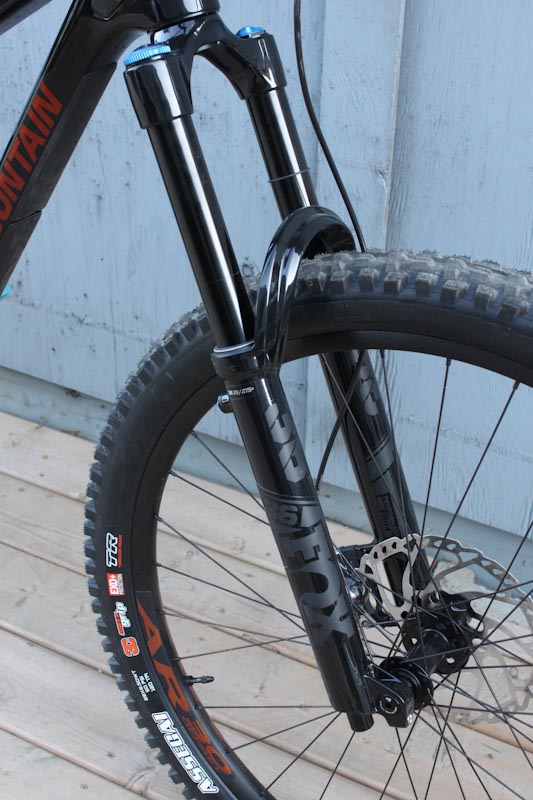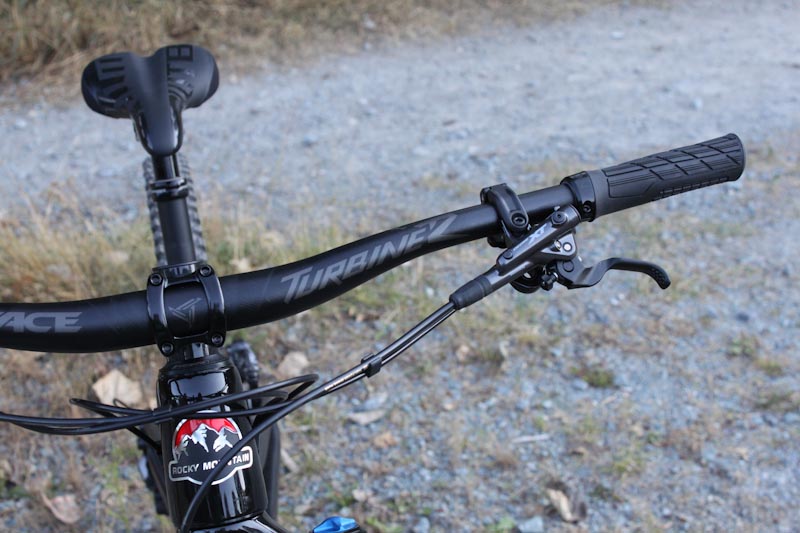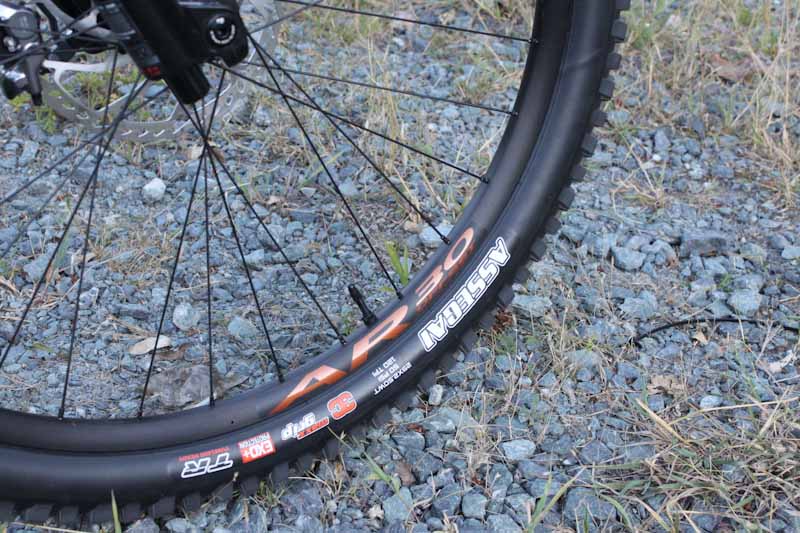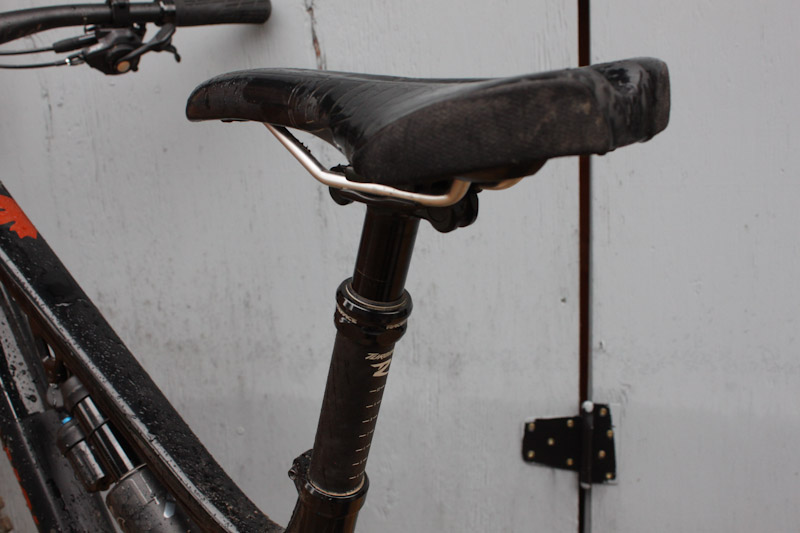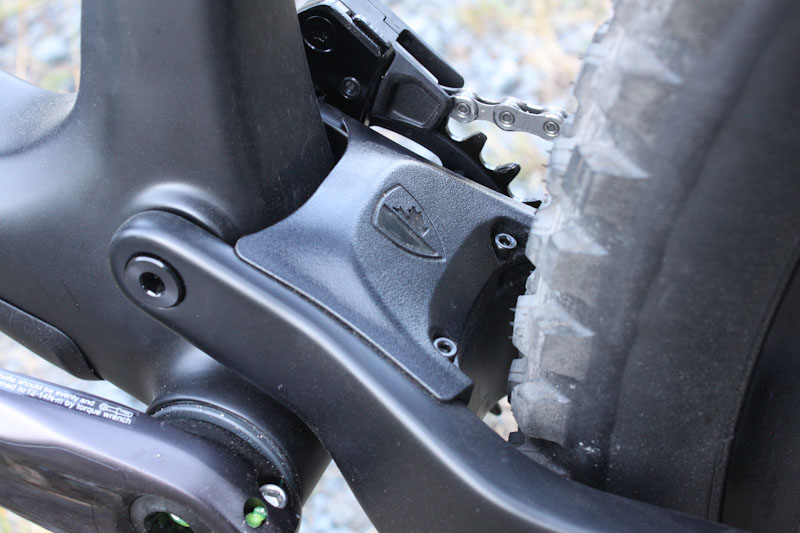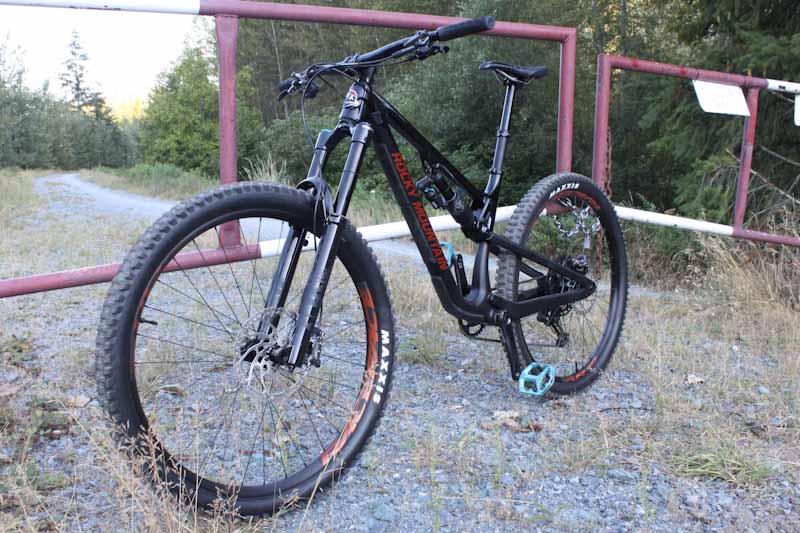After holding down the long travel trail category for many years, Rocky Mountain Bikes’ Altitude has stretched its legs and grown into a full enduro machine for 2021. With 170/160mm travel, modern geometry, adjustable chainstays and the Ride 9 chip’s tunability, this bike easily meets today’s enduro standards in slack and long mode. But while that’s always fun, what impressed me was the Altitude’s versatility, as it offers a very trail friendly ride when it’s set up steeper and shorter.
Where some enduro bikes put off a more brutish vibe, the Altitude’s leaner looks give you a sense that this bike would be pretty good at climbing and trail rambling too. The bike’s aesthetics suit its wide ranging capabilities perfectly; it’s a lean but mean machine that can be a real wolf in sheep’s clothing.
This article is all about how the Altitude Carbon 70 29 rides, so check out my launch article for all the details on Rocky Mountain’s 2021 Altitude lineup.
2021 Rocky Mountain Altitude shock tuning:
Where previous RMB bikes I’ve ridden followed factory recommendations for rear shock air pressures (often your body weight in psi), the new Altitude linkage features a more linear rate curve and a higher average leverage ratio, so it requires a little extra pressure.
Where I usually run 140psi in a ‘psi = body weight’ situation, I settled on 170psi for the Altitude Carbon 70’s Fox Float X2 rear shock. RMB’s chart suggests 180, but going a bit on the low side is consistent with my usual setup (I weigh about 145lbs without gear). The Float X2 shock only offers low-speed compression and rebound adjustments. I set both to their factory recommendations (LSC ¾ to fast and LSR halfway) and that seemed to work well for me.
Ride 9 chip tuning:
RMB’s Ride 9 chip is an interesting adjuster, as it alters both the geometry and suspension characteristics: Let’s start with geometry. From Pos. 1 (slack) to Pos. 9 (steep), your key angles don’t change much as the head tube varies from 64.4° to 65.5°, and the seat mast goes from 75.4° to 76.5°. Reach ranges more, stretching from 449mm to 461mm. BB drop in Pos. 1 is 34mm, but that goes up to 19mm in Pos. 9. Up front, stack height varies from 624mm in slack to 616mm in steep mode.
As for suspension, the chip allows you to fine-tune how progressive or linear the Altitude feels. As you move numerically from Pos. 1 through to Pos. 9, the shock rate steadily gets less progressive and more linear.
The effect the Ride 9 chip has on geometry is logical; As the bike goes from slacker to steeper the reach increases, the BB rises and the stack height drops, moving you from a slightly laid back, downhill friendly stance into a more aggressive trail riding position. While it makes sense to have the shock grow more progressive as you go slacker, I have one issue with that as a lightweight rider: I can’t bottom out the Altitude in its slackest few positions, yet I’d love to keep the bike fully slacked out for my local terrain.
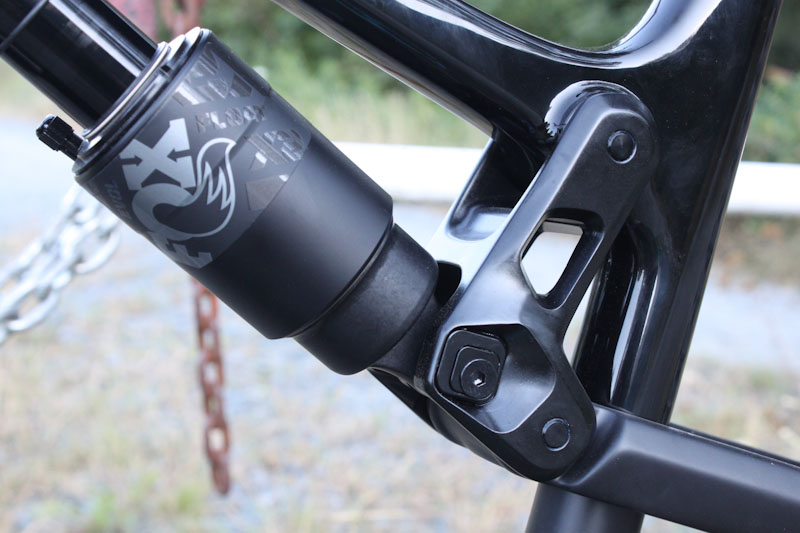
I did start out with the Altitude in the slackest Pos. 1, but soon bumped it up to Pos. 4. In that setting I’m using almost all my travel on most laps, and it still takes a hard hit to bottom out. Relying on the Ride 9 chip to tune the shock rate does mean that when I find the setting that’s linear enough for me, I’m limited to whatever geometry that setting provides…. thankfully it doesn’t change that much. Going to Pos. 4 steepened my steering angle by 0.4°, but the BB still feels low at a 29mm drop and I’m quite comfortable with the 453mm reach.
What I should have considered sooner was tuning the rear shock. On medium bikes the Altitude Carbon 70’s Fox Float X2 comes with one spacer installed, and in hindsight I should have pulled it rather than relying on the chip to reduce the bike’s progressivity. With that spacer removed, I could have retained slacker geo while keeping the suspension more linear. I should also note that RMB specifically tunes the Altitudes’ rear shocks for each frame size, and if your body weight is closer to average I’d bet the stock setup would be pretty spot-on.
Given that my local trails suit slacker bikes, I only ventured halfway towards the Ride 9 chip’s steeper end. Just between Pos. 1 and Pos. 4, the Altitude’s slightly steeper head angle, higher BB and longer reach are easily noticeable. If your trails are more XC than enduro (or you’re taking the Altitude through different areas) you can push the bike even further into trail friendly mode. I can assure you the Ride 9 chip’s tuning range should allow the Altitude to get comfortable on any trail network that justifies a long travel bike.
Suspension:
Climbing:
The Altitude was tuned to offer a soft initial stroke, a supportive mid and a fairly progressive end stroke. Rocky has done a fine job improving the initial stroke softness, as the Altitude smooths over small bumps very well and offers a comfortable ride on singletrack. I’ve always found rear-wheel traction quite good on RMB’s bikes, and the Altitude’s soft-off-the-top tune definitely helps the rear tire crawl over small or mid-sized obstacles instead of bouncing up them. I’d say Rocky Mountain did well by lightening up the overall tune of the Altitude, as it offers a highly sensitive ride without sacrificing pedalling efficiency or mid stroke support.
I find Rocky Mountain’s Smoothlink four bar linkage climbs best with a rear shock in Firm or Climb mode. It’s an active rear end that will happily move upon impacts big or small, so I prefer to take the added pedalling support from the shock knowing I’ll still have good bump absorption and traction. With the shock wide open the Altitude will give a little up and down with each pedal stroke, so unless you’re clambering up something really technical, I find a firmed up shock pairs well with this linkage for climbing.
At first I thought the Altitude’s mid stroke seemed soft, as the bike will dive fairly deep into its travel on a climb. However, after monitoring my o-ring obsessively I confirmed the rear wheel is moving for bumps, but you’re not sagging or sinking into your travel because of pedalling forces. On smooth sections of trail I was riding higher in the travel, and the bike always felt well supported against cranking efforts. When things get rougher, the linkage will give in to suck up the bumps.
Descending:
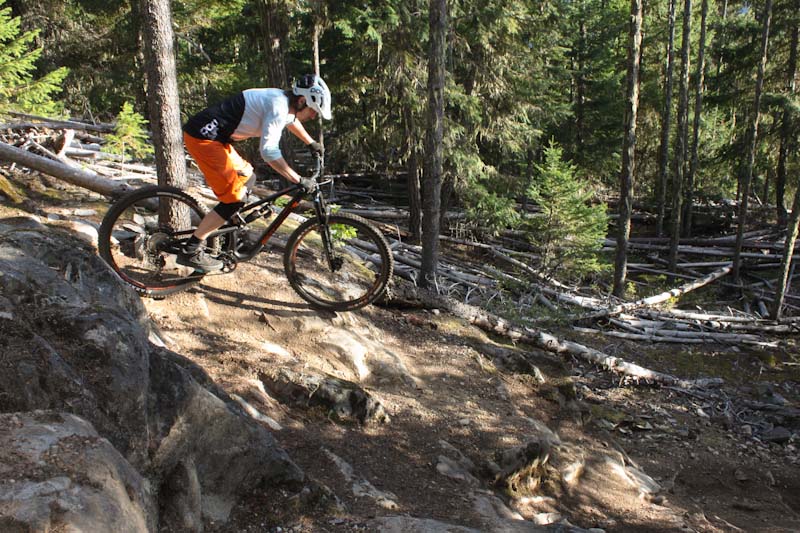 As soon as you switch the rear shock into wide open mode, you can feel the bike sinking further into its travel before it starts to ramp up. Yet while the bike goes into bump absorbing mode, you don’t lose your mid stroke support: The Altitude offers RMB’s typically poppy ride, happily hopping root clusters and launching off jumps. In the corners, the bike doesn’t wallow too easily and always seems eager to spring out of berms.
As soon as you switch the rear shock into wide open mode, you can feel the bike sinking further into its travel before it starts to ramp up. Yet while the bike goes into bump absorbing mode, you don’t lose your mid stroke support: The Altitude offers RMB’s typically poppy ride, happily hopping root clusters and launching off jumps. In the corners, the bike doesn’t wallow too easily and always seems eager to spring out of berms.
When big hits come along, the Altitude will deal with them quickly but this linkage doesn’t round off or dull sharp hits as much as some other designs. Where some bikes eat up bumps so smoothly they can feel numb on the trail, the Smoothlink linkage doesn’t plow through larger hits that way. There is more noticeable feedback from the trail below, but what Rocky’s linkage does well is recover quickly and encourage your rear tire to find traction in rough terrain. I’ve found this rear end is very comfortable tracing chattery sections of trail at high speeds and keeping you glued to chunky rocks. It may have different tuning requirements, but the 2021 Altitude’s rear suspension rides a lot like other Rocky Mountains I’ve tested.
With the Ride 9 chip in play the Altitude doesn’t have an inherent degree of end stroke ramp-up. It’s up to each rider to choose the setting that’s ideally linear or progressive for their riding style, but I can attest that each setting makes an incremental difference, and there is quite a range to play with.
Long vs. Short mode:
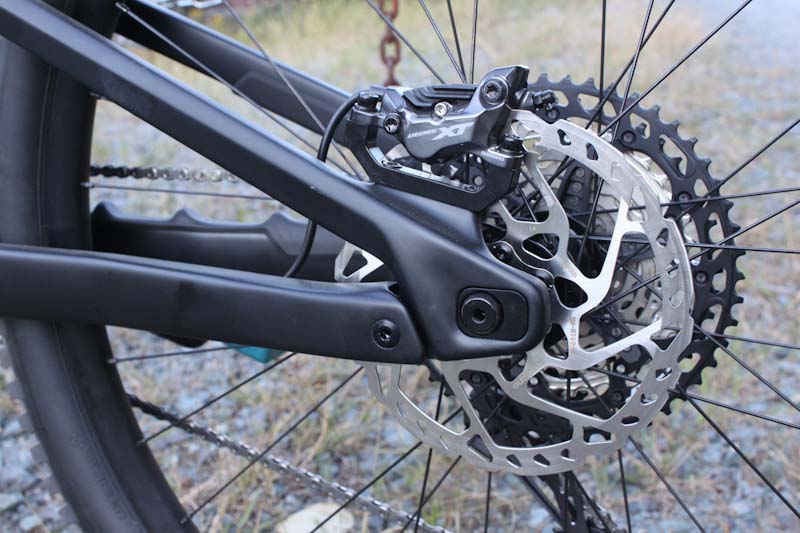
Since the new Altitude’s chainstay length is adjustable you can choose from a short and snappy or long and stable ride, and flipping that chip makes an obvious difference to the bike’s character. I started with the Altitude in Short mode, which already offers a well-balanced rider position, but when I went to Long mode it was like hitting a ‘Stability Boost’ button!
On my first descent, I could immediately feel the extra 10mm out back providing a lot more high-speed stability. The added wheelbase makes it feel like your body weight sinks deeper between the wheels and the Altitude suddenly rides with a big rig feel that’s comparative to Rocky Mountain’s Slayer or Trek’s Slash. Before adjusting the dropouts I already thought this bike was a very versatile machine, but the Long/Short modes amplify the Altitude’s range even more, and steps its handling up to rival the biggest enduro sleds out there.
Technically changing the dropout position does alter the Altitude’s shock rate too, but it has a pretty minimal effect. I really didn’t notice any difference when I moved from Short to Long mode and left the Ride 9 chip where it was.
I didn’t find the lengthened chainstays hampered climbing in any way. At climbing speeds the extra 10mm marginally reduces the bike’s agility, so you won’t be struggling through tight switchbacks. If anything I found traction improved, and noticed on steep uphill pitches the longer rear end helps keep the front wheel from lifting up. If I owned an Altitude I would primarily keep it in Long mode, as I felt the added stability helped with both climbing and descending.
Other notes:
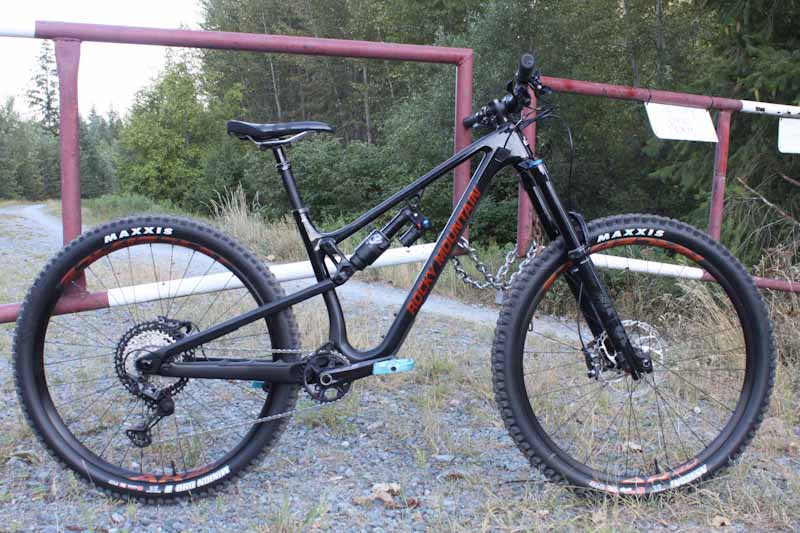 The Altitude’s updated Smoothwall carbon frame is impressively stiff. It looks lean but its shapely new tubing keeps things feeling pretty solid upfront. And the same goes for the carbon rear end, which also looks long and leggy but holds a line through rough terrain better than your eyes might suggest. The new dual bearing design at the chain/seatstay junction also contributes to the Altitude’s rear-end stiffness.
The Altitude’s updated Smoothwall carbon frame is impressively stiff. It looks lean but its shapely new tubing keeps things feeling pretty solid upfront. And the same goes for the carbon rear end, which also looks long and leggy but holds a line through rough terrain better than your eyes might suggest. The new dual bearing design at the chain/seatstay junction also contributes to the Altitude’s rear-end stiffness.
I’ll give kudos to RMB for keeping the Altitude Carbon 70 29’s weight on the lighter side. 32.25lb (14.63kg) with pedals is impressive for a 29” wheeled, long travel enduro race bike. The low weight also makes this bike more attractive to those who plan to enjoy its versatility with long loops on mellower trails.
Components:
The Altitude Carbon 70 29 comes with Fox’s 36 Performance Elite Fork, with a Fit Grip 2 damper. I find Fox’s forks perfectly fine in terms of how smoothly they absorb bumps, but I found this 36 ramps up earlier than my personal RockShox Lyrik (both have no tokens inside). I’m running the air pressure suggested for someone 20lbs lighter than me, and the high and low compression both wide open. That got the fork dialed in, but I’ve noticed I often have to set up Fox’s forks lighter than recommended whereas I can run RockShox forks close to their factory suggestions and enjoy a perfectly plush ride.
Shimano’s XT 4-piston brakes offer tons of stopping power, but I did find them a bit grabby. I usually ride SRAM brakes, and I definitely noticed myself locking up wheels when I didn’t mean to with the XT’s. Modulation could be a bit better, but I appreciate the XT’s sheer power and never noticed any fade from their finned pads. I had no problems with the XT drivetrain components, and heard no creaking from the press-fit BB92 bottom bracket.
The Altitude offers a modern cockpit with a stubby Rocky Mountain 35mm stem for snappy steering. The 780mm RaceFace Turbine R handlebar is ample but an 800mm bar might save a few customers from swapping them out. I was happy to see Ergon’s GE1 EVO grips as stock equipment, as I like their semi-ergonomic shape.
RaceFace’s AR30 rims are a tough set of hoops, showing almost no damage after several weeks of test rides. I’ve taken one wheel out of true by maybe 2mm’s, and the rims’ black finish has resisted all but a few tiny rock strikes. I have no complaints about the grippy Maxxis tire setup, with a 2.5” Assegai up front and a 2.4” Minion DHR II in the rear (both 3C Maxxgrip/MaxxTerra EXO+ casings).
Unfortunately the 150mm RaceFace Turbine R dropper post got sticky on me many times throughout my test. It often stuck on the first lift fresh out of the shed, and also frequently topped out at less than full travel. I tried loosening the seat collar, but proved that wasn’t an issue. Fortunately, I found the Altitude’s stock WTB’s Volt saddle comfortable enough that replacing it would simply be a luxury.
Finally, One Up Components’ V2 chain guide never let my chain skip off, and RMB’s new Canadian Shield mudguard does build up with muck, but is much easier to wipe clean than the cables running beneath it.
The 2021 Altitude Carbon 70 29 retails for $6999. Frames are available in S/M/L/XL sizes, but please note Small frames run 27.5” wheels, Medium frames offer the option of 27.5” or 29” wheels, and L and XL bikes come on 29’s only. Color options are Grapevine/Black Dog/Heartbreaker or Black Dog/Rusted From the Rain.
